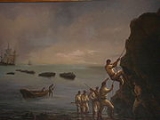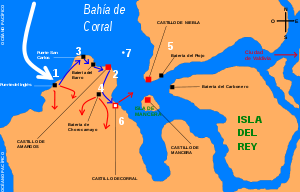
Capture of Valdivia
Encyclopedia

Spanish Empire
The Spanish Empire comprised territories and colonies administered directly by Spain in Europe, in America, Africa, Asia and Oceania. It originated during the Age of Exploration and was therefore one of the first global empires. At the time of Habsburgs, Spain reached the peak of its world power....
forces commanded by Colonel
Colonel
Colonel , abbreviated Col or COL, is a military rank of a senior commissioned officer. It or a corresponding rank exists in most armies and in many air forces; the naval equivalent rank is generally "Captain". It is also used in some police forces and other paramilitary rank structures...
Manuel Montoya and the Chile
Chile
Chile ,officially the Republic of Chile , is a country in South America occupying a long, narrow coastal strip between the Andes mountains to the east and the Pacific Ocean to the west. It borders Peru to the north, Bolivia to the northeast, Argentina to the east, and the Drake Passage in the far...
an forces under the command of Lord Cochrane
Thomas Cochrane, 10th Earl of Dundonald
Admiral Thomas Cochrane, 10th Earl of Dundonald, 1st Marquess of Maranhão, GCB, ODM , styled Lord Cochrane between 1778 and 1831, was a senior British naval flag officer and radical politician....
, held on 3 and 4 February of 1820.
Background
After failing to capture the Spanish fortress of Real Felipe in El Callao, Cochrane decided to assault the city of ValdiviaValdivia, Chile
Valdivia is a city and commune in southern Chile administered by the Municipality of Valdivia. The city is named after its founder Pedro de Valdivia and is located at the confluence of the Calle-Calle, Valdivia and Cau-Cau Rivers, approximately east of the coastal towns of Corral and Niebla...
, the most fortified place in South America at the time. Valdivia was considered a threat to Chilean independence as it was a stronghold and supply base for Spanish troops. Valdivia provided a safe landing site for sending reinforcements to the loyalist guerrilla fighting the Guerra a muerte
Guerra a muerte
Guerra a muerte is a term coined by Benjamín Vicuña Mackenna used in Chilean historiography to describe the irregular, no-quarter warfare that broke out from 1819 to 1821 during the Chilean War of Independence...
in the area of La Frontera.
Valdivia was isolated from the rest of Chile by native Mapuche
Mapuche
The Mapuche are a group of indigenous inhabitants of south-central Chile and southwestern Argentina. They constitute a wide-ranging ethnicity composed of various groups who shared a common social, religious and economic structure, as well as a common linguistic heritage. Their influence extended...
territory, and the only entrance to Valdivia was Corral Bay
Corral Bay
Corral Bay is a bay in the mouth of the Valdivia River, southern Chile. Its main towns are Corral and Niebla. The mouth of the bay is between Juan Latorre point and Morro Gonzalo, with a width of 5.5 km. All the year the bay is transited by merchant, transport and fish boats...
, at the mouth of Valdivia River
Valdivia River
The Valdivia River or Río Valdivia, as it is known locally, is a major river in southern Chile. It is the continuation of the Calle-Calle River, from the point where it meets the Cau-Cau River in the city of Valdivia. The Valdivia river ends in Corral Bay, on the Pacific coast. Other tributaries...
. The bay was protected by several forts built to prevent pirate raids or any attack from a foreign nation.
Fortifications
The defenses at Valdivia consisted of a number of forts and defensive positions. On the South side of the habour were four forts - Fort Ingles, Fort San Carlos, Fort Amargos and Fort Chorocomayo. Further inland was Corral Castle to defend against a landward assault. On the Northern side was the stone walled Fort Niebla. Mancera IslandMancera Island
Mancera Island is a minor island at the mouth of Valdivia River, in southern Chile. It was named after the Spanish viceroy of Peru Pedro de Toledo, 1st Marquis of Mancera, who fortified the island. The fort was a vital point in the Valdivian Fort System, preventing enemy ships from reaching...
in the centre of the habour was also heavily garrisoned.
Battle
Facing these powerful fortifications, Lord Cochrane decided to attack the forts from the land in an amphibious nighttime operation. The troops landed south of the bay on the Aguada del Ingles (the English Beach). Taken by surprise, the Fort Ingles was captured quickly, with the fugitives running towards the next fort, Fort San Carlos. The attackers got in among the fleeing Spanish troops and in the confusion were able to capture San Carlos and subsequently the other two forts on the south side of the habour, with only Fort Chorocomayo showing brief resistance before capitulating.After the success of the attack on the forts of the southern shore, Cochrane called a halt for the night. He anticipated an altogether grimmer fight in the morning to capture the remaining fortifications, as he had lost the element of surprise. However, in the morning the commanders of the other forts unexpectedly decided to surrender without a fight, with the garrisons of Fort Niebla and Mancera Island
Mancera Island
Mancera Island is a minor island at the mouth of Valdivia River, in southern Chile. It was named after the Spanish viceroy of Peru Pedro de Toledo, 1st Marquis of Mancera, who fortified the island. The fort was a vital point in the Valdivian Fort System, preventing enemy ships from reaching...
retreating upstream. The town of Valdivia surrendered soon after.
Reason for the loss
The overwhelming reason for the loss was the appalling morale of the Spanish troops in Chile, eroded by corruption and the sense that the war against the rebels in Chile was lost. They also held a deeply superstitious belief that Cochrane was a 'devil' and therefore could not be defeated.Aftermath
The Spanish troops inside Valdivia itself sacked the city andthen went to Osorno. These troops later moved to reinforce Chiloé Island
Chiloé Island
Chiloé Island , also known as Greater Island of Chiloé , is the largest island of the Chiloé Archipelago off the coast of Chile, in the Pacific Ocean...
which was the last Spanish possession in Chile. Lord Cochrane tried to conquer the island without success.
The capture of Valdivia effectively ended the last vestiges of Spanish power in mainland Chile and opened up the way for Chilean and Peruvian independence.

